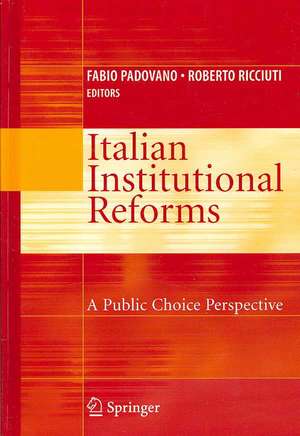Italian Institutional Reforms: A Public Choice Perspective
Editat de Fabio Padovano, Roberto Ricciutien Limba Engleză Hardback – 7 noi 2007
| Toate formatele și edițiile | Preț | Express |
|---|---|---|
| Paperback (1) | 639.41 lei 6-8 săpt. | |
| Springer – 29 oct 2010 | 639.41 lei 6-8 săpt. | |
| Hardback (1) | 645.60 lei 6-8 săpt. | |
| Springer – 7 noi 2007 | 645.60 lei 6-8 săpt. |
Preț: 645.60 lei
Preț vechi: 759.54 lei
-15% Nou
Puncte Express: 968
Preț estimativ în valută:
123.53€ • 128.98$ • 102.24£
123.53€ • 128.98$ • 102.24£
Carte tipărită la comandă
Livrare economică 05-19 aprilie
Preluare comenzi: 021 569.72.76
Specificații
ISBN-13: 9780387721408
ISBN-10: 0387721401
Pagini: 247
Ilustrații: XXVIII, 248 p.
Dimensiuni: 155 x 235 x 18 mm
Greutate: 0.56 kg
Ediția:2008
Editura: Springer
Colecția Springer
Locul publicării:New York, NY, United States
ISBN-10: 0387721401
Pagini: 247
Ilustrații: XXVIII, 248 p.
Dimensiuni: 155 x 235 x 18 mm
Greutate: 0.56 kg
Ediția:2008
Editura: Springer
Colecția Springer
Locul publicării:New York, NY, United States
Public țintă
ResearchCuprins
Pressure on Bank of Italy: Evidence Using a Taylor Rule.- A Simulative Assessment of the Italian Electoral System.- Did the Italian Public Finances Converge to European Standards after the EMU?.- Are The Income Policy Agreements Of 1992-93 In Italy Still Valid?Towards A Theory For The Optimal Design Of The “Social Pact”In The European Monetary Union.- Laws and Legislature Size in Italian Regions: Which Will Be the Effect of an Increase in the Number of Legislators?.- Setting House Taxes by Italian Municipalities: What the Data Say.- How Do Institutions Shape Policy Making? The Transition from Parliamentarism to Presidentialism in Iitalian Local Governments.- Thirty Years of Reforms to Budget Rules in Italy: An Econometric Evaluation.- The “Demand for Justice” in Italy: Civil Litigation and the Judicial System.- The creation of Independent Authorities in Italy.- The Regional Organization of Hospital Care in Italy: The Effects of Asymmetry of Information and Soft Budget Constraint Rules.- The Channeled Italian Voters.
Textul de pe ultima copertă
Using a public choice perspective, this book explains the evolution and political and economic impact of recent changes to the Italian institutional framework. Because these changes are so numerous and broad, their implementation serves as a case study for other Western governments. Particular attention is paid to the introduction of the EURO, the reform of voting from proportional to majoritarian rule, the impact of corporatism, constraints imposed by the Maastricht Treaty, and the switch from a highly centralized government to a federal organization.
Caracteristici
The first book to apply a public choice/political economy approach to the study of Italy's institutional reforms Existing books view the reforms from a political science perspective










